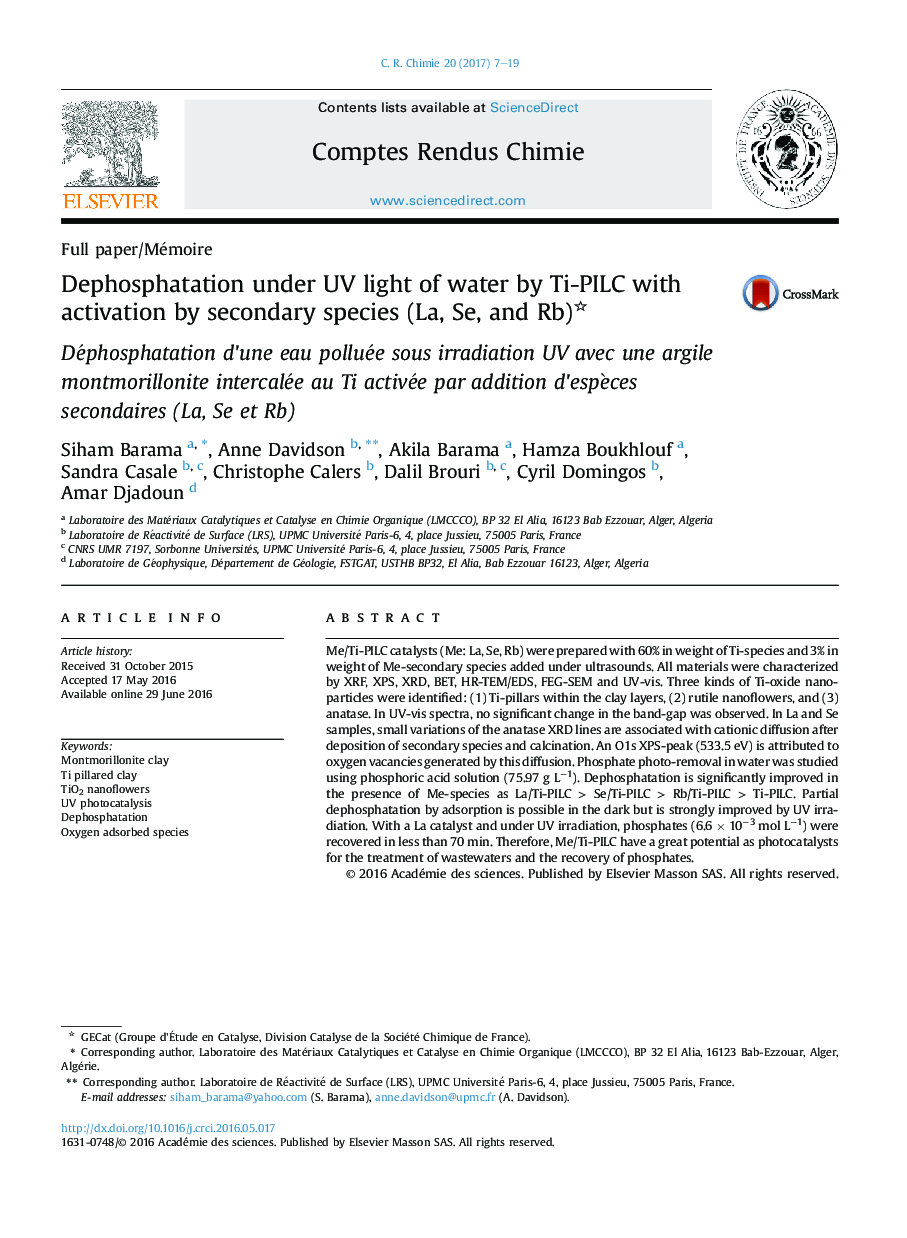| کد مقاله | کد نشریه | سال انتشار | مقاله انگلیسی | نسخه تمام متن |
|---|---|---|---|---|
| 6468865 | 1362328 | 2017 | 13 صفحه PDF | دانلود رایگان |

Me/Ti-PILC catalysts (Me: La, Se, Rb) were prepared with 60% in weight of Ti-species and 3% in weight of Me-secondary species added under ultrasounds. All materials were characterized by XRF, XPS, XRD, BET, HR-TEM/EDS, FEG-SEM and UV-vis. Three kinds of Ti-oxide nanoparticles were identified: (1) Ti-pillars within the clay layers, (2) rutile nanoflowers, and (3) anatase. In UV-vis spectra, no significant change in the band-gap was observed. In La and Se samples, small variations of the anatase XRD lines are associated with cationic diffusion after deposition of secondary species and calcination. An O1s XPS-peak (533.5 eV) is attributed to oxygen vacancies generated by this diffusion. Phosphate photo-removal in water was studied using phosphoric acid solution (75.97 g Lâ1). Dephosphatation is significantly improved in the presence of Me-species as La/Ti-PILC > Se/Ti-PILC > Rb/Ti-PILC > Ti-PILC. Partial dephosphatation by adsorption is possible in the dark but is strongly improved by UV irradiation. With a La catalyst and under UV irradiation, phosphates (6.6 Ã 10â3 mol Lâ1) were recovered in less than 70 min. Therefore, Me/Ti-PILC have a great potential as photocatalysts for the treatment of wastewaters and the recovery of phosphates.
RésuméLes catalyseurs Me/Ti-PILC (Me: La, Se, Rb) ont été préparés avec 60% en poids de Ti et 3% en poids d'espèces secondaires métalliques Me dispersées sous ultrasons. Tous les matériaux ont été caractérisés par FX, SPX, DRX, BET, HR-MET/EDS, FEG-MEB et UV-vis. Trois types d'oxydes de Ti ont été identifiés: 1) piliers de Ti à l'intérieur des couches d'argile, 2) nanofleurs rutile, 3) anatase. Dans les spectres UV-vis, aucun changement significatif de la bande interdite n'a été observé. Dans les Diffractogrammes RX des échantillons au La et Se, de faibles déplacements des raies de l'anatase sont observés et sont dus à la diffusion cationique. Un pic SPX de O1s (533.5eV) est attribué à des lacunes d'oxygène générées par cette diffusion. La photo-élimination des phosphates dans l'eau a été étudiée en utilisant une solution d'acide phosphorique (75.97 g.Lâ1). La déphosphatation est significativement améliorée en présence d'espèves Me, dans l'ordre: La/Ti-PILC> Se/Ti-PILC> Rb/Ti-PILC>Ti-PILC. Une déphosphatation partielle par adsorption est possible dans l'obscurité, mais elle est fortement améliorée par une irradiation UV. Avec le catalyseur au La et sous irradiation UV, 6,6Ã10â3mol Lâ1 de phosphates ont été récupérés en moins de 70 min. Par conséquent, les solides Me/Ti-PILC ont un grand potentiel en tant que photocatalyseurs pour le traitement des eaux usées et la récupération des phosphates.
Journal: Comptes Rendus Chimie - Volume 20, Issue 1, January 2017, Pages 7-19